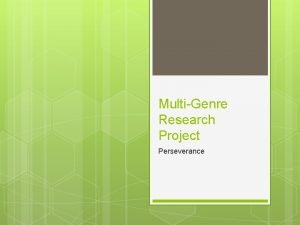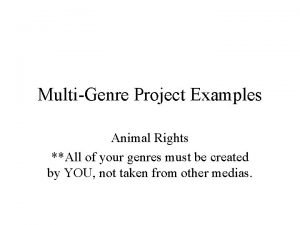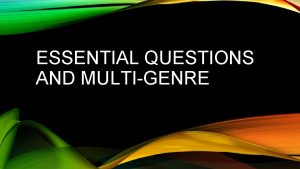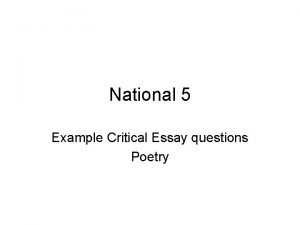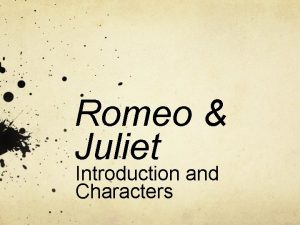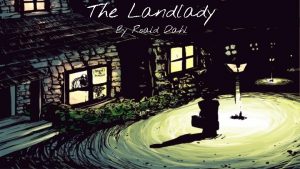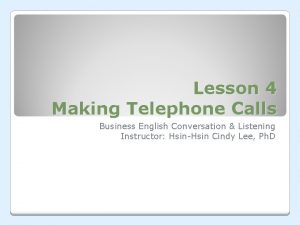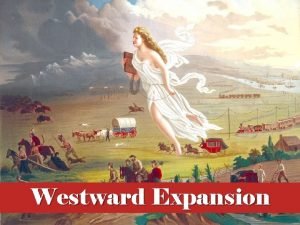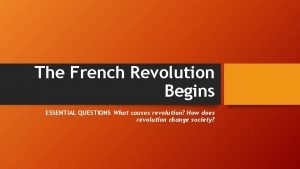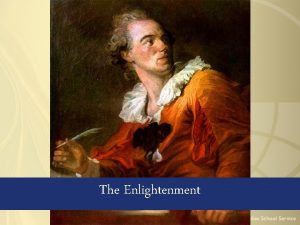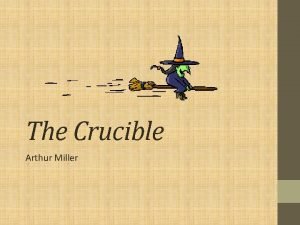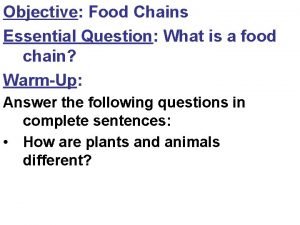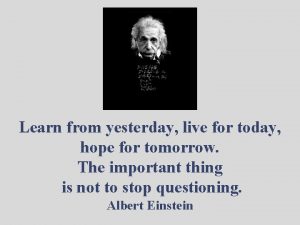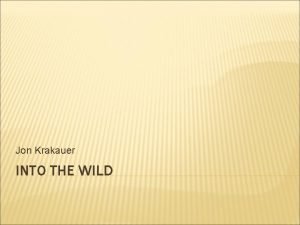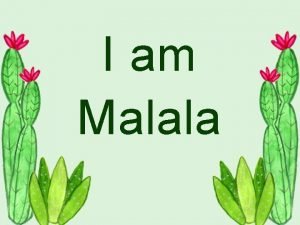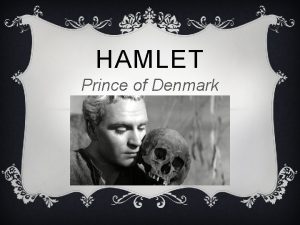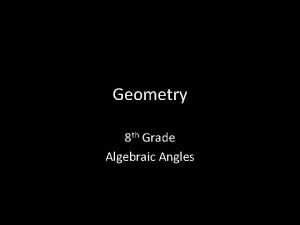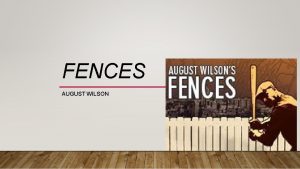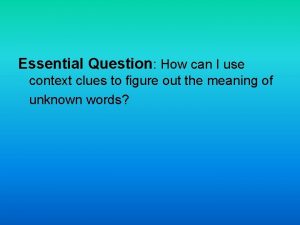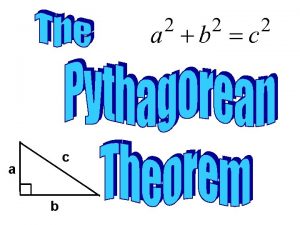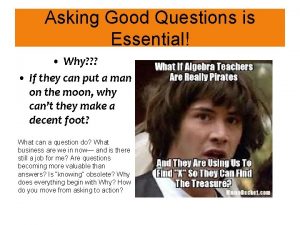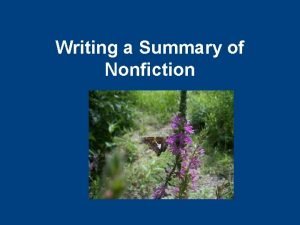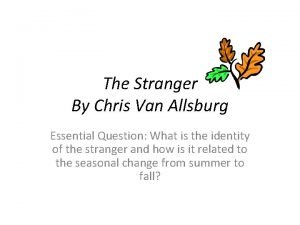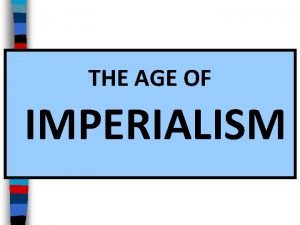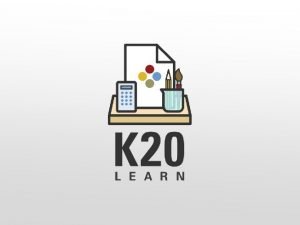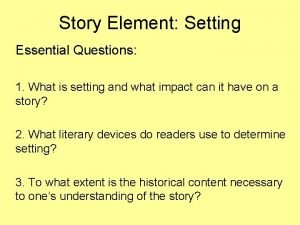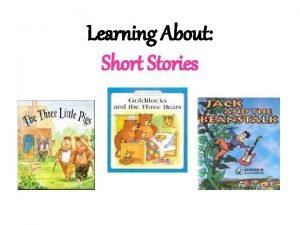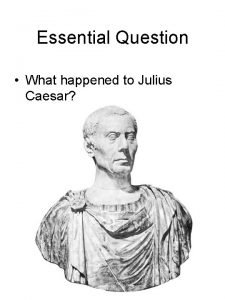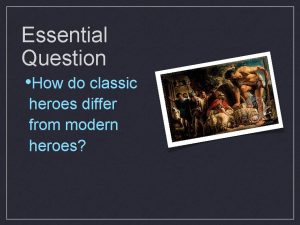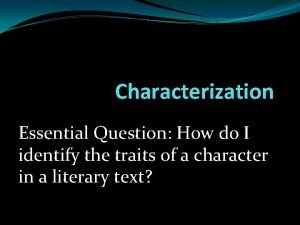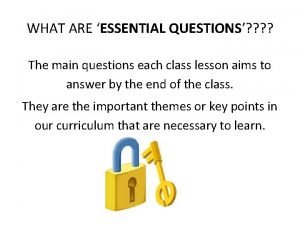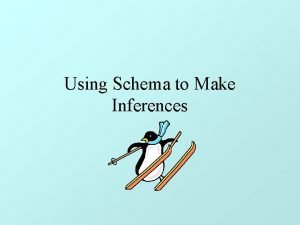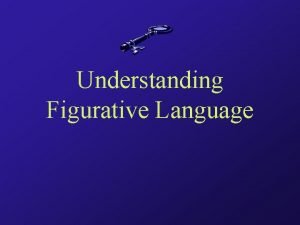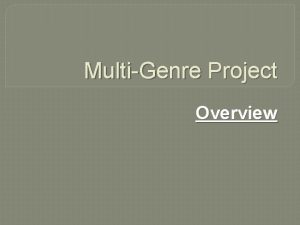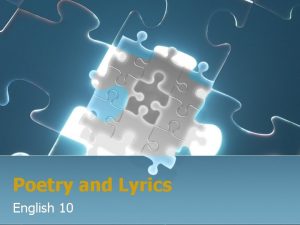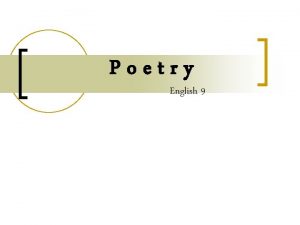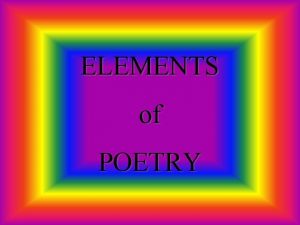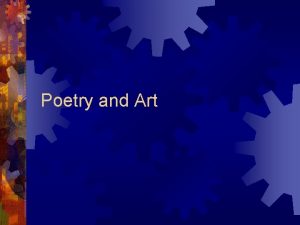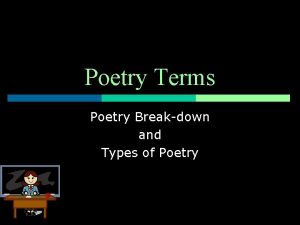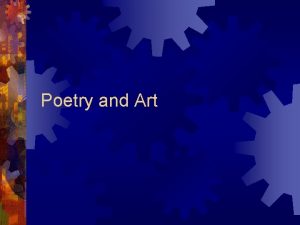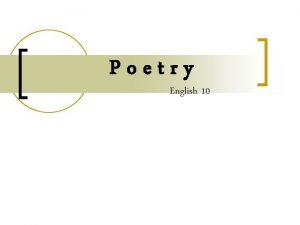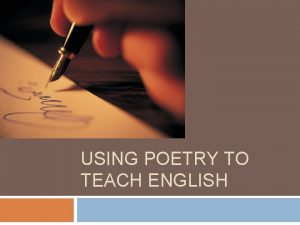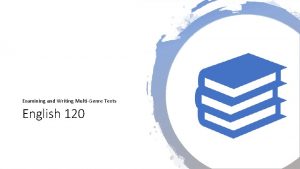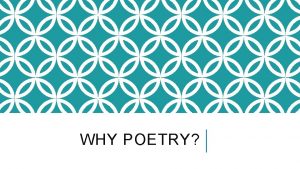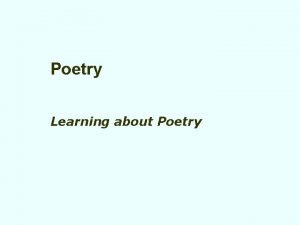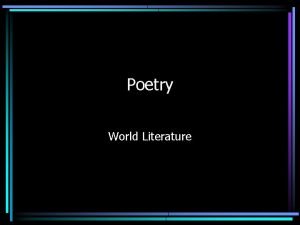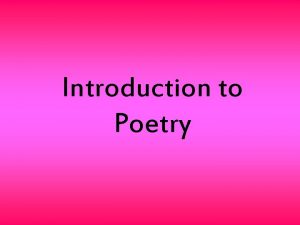ESSENTIAL QUESTIONS AND MULTIGENRE WHY English Poetry Unit

















































- Slides: 49

ESSENTIAL QUESTIONS AND MULTI-GENRE

WHY? • English: • Poetry Unit • Short Story Unit • Novel Unit • Essential Questions, on the otherhand, allow you to explore many different genres because you are not limited to style- the priority is that you explore different answers to the question. • You use critical thinking skills to approach the issue at hand. • Well then what is an Essential Question?

ESSENTIAL QUESTIONS • Have no simple “right” answer • Provoke & sustain inquiry • Address conceptual or philosophical foundations • Raise other important questions • Naturally & appropriately recur • Stimulate vital, ongoing rethinking

EXAMPLES • What is a true friend? • To what extent does art reflect culture or shape it? • Is everything quantifiable? • To what extent is DNA destiny? • In what ways is algebra real and in what ways is it unreal?

MORE EXAMPLES… • To what extent is US history a history of progress? • How would you define a utopian society? • How does conflict lead to change? • How do we form and shape our identity? • Is humankind inherently good or evil?

TYPES OF ESSENTIAL QUESTIONS • Overarching: Frame courses and programs of study around truly big ideas • Topical: Are unit specific but still promote inquiry GOOD TEACHING USES BOTH!

OVERARCHING: HOW CAN WE EVER TRULY BE CERTAIN OF OUR REALITY? : IS FEAR ESSENTIAL TO OUR WELLBEING?

TOPICAL: WHAT DOES THE WORK OF STEPHEN KING TEACH US ABOUT THE PSYCHOLOGY OF FEAR?

WHAT IS FEAR? Irrational Fear/Phobia • is the fear of something that is: • *Harmless. What is feared can not cause death, injury, illness, dismemberment, or ruin someones reputation. Rational Fear • Truly dangerous. Can cause death, severe injury, dismemberment, illness, or ruin someones reputation. • *Something dangerous with a high probability of occurring. • *Something potentially dangerous, but whose probability of occurring is extremely low or not possible. • *A fear of a dangerous situation which is seen clearly and undistortedly. • *A fear where the danger is misjudged or magnified. • *A fear resulting from well examined conclusions and evidences and based on the law of probability.

Childhood Hauntings Fantasia (1940) • • • The film consists of eight animated segments set to pieces of classical music conducted by Leopold Stokowski. the film "integrates famous works of classical music with wildly uneven but extraordinarily imaginative visuals that run the gamut from dancing hippos to the purely abstract” https: //www. youtube. com/watc h? v=SLCu. L-K 39 e. Q

a l u t n a Tar

MAN IN THE BLACK SUIT Stephen King (1995)

WHAT DO THESE STORIES PREY ON? ? WHY IS STEPHEN KING SO SUCCESSFUL?

READING • There is a copy of the story for every two people. • You must read it together and annotate each page. • • • Unknown Words Literary Devices Predictions Personal Comments Quesitons

AGENDA • Terror vs. Horror • Finish reading Man in the Black suit individually • Work on Questions 1 -6 • “Conclusion Bank” • Danse Macabre – Class Read

CRASH COURSE IN GOTHIC LITERATURE

CHARACTERISTICS • Set in Medieval times • Dark, mysterious, evil tone • Dark castles, palaces, chambers, haunted mansions • Isolated setting • All come together to emphasize the sense of evil http: //www. encounterspri. com/Articles. ht m

MORE CHARACTERISTICS • Presence of ghosts, spirits, vampires, and other supernatural entities • Mysterious disappearances and reappearances • Supernatural or paranormal occurrences http: //www. penelopesweb. com/gargoyles. html

CHARACTERISTICS -- CONT’D. • Religion, usually Christianity or at least spirituality, is confronted. • A gothic “double” is used in which a character who seems to be good is linked with another who is evil www. pagedepot. com/. . . / GOTHIC%20 CHAPBOOKSX. HTM

MORE CHARACTERISTICS • • Blood, pain, death Cruelty Eroticism Characters with “aberrant psychological states” • Events are “uncanny, macabre, or melodramatically violent bordering between reality and unreality http: //www. pantip. com/cafe/chalermthai/newmovi e/hauntedcastle/hc. html

PURPOSE • To evoke “terror” versus “horror” in the reader because of situations bordering reality/unreality • Often used to teach a message • May lack a Medieval setting but will develop an atmosphere of gloom and terror

DIFFERENTIATING BETWEEN THE TWO • Horror • “An awful apprehension” • Described distinctly • Something grotesque • So appalling, unrealistic • Depends on physical characteristics • Terror • “A sickening realization” • Suggestive of what will happen • Depends on reader’s imagination • Sense of uncertainty • Creates an “intangible atmosphere of spiritual psychic dread”

AMERICAN GOTHIC • Important from the mid-18 th Century on • Related to “Romantic Period” • Criticizes “national myth of newworld innocence by voicing the cultural contradictions that undermine the nation’s claim to purity and equality” - Teresa A. Goddu • Tells of historical horrors that make national identity http: //photos 1. blogger. com/img/154/1420/1024/american% 20 gothic. jpg


CONCLUSIONS BASED ON SHORT STORY • Plausability is essential • Loss of Innocence/ Traumatic childhood memory • Fragility of Sanity • Guilt • The Unknown • The vehicle for all of this is our own imaginations.

SHORT FILM • This film is not by Stephen King, but the Anchor Text is so we can explore any other genre as long as it links to our essential question and its exploration. • What is the psychology behind this short film?

HAS GUILT EVER HAUNTED YOU? ? ……

CREATIVE WRITING Challenge: To scare your classmates with your story of terror! • Your story must be based on one of the principles of fear which we have explored: 1. What would be ‘poetic justice’ if you were ‘punished’ for your guilt? Ex. Forever tormented with horrible partners/never to fall in love because you didn’t warn your friend that their partner was cheating on them. 2. An ‘unknown’ that can strike terror in you. Ex. Space, Absolute silence/ Deepest Ocean Depending on the principle/ conclusion that you decide to write about you may have a story with a beginning, middle and end OR you may wish to vividly describe a scenario that someone could find themselves. The latter requires even more imagery so that you can essentially HYNOTIZE your audience. We’ll share these during tomorrow’s class and see who places in the top 5 for most thrill/ fear inducing writing.

DAY ONE OF GROUP WORK 1. Find your group 2. Get out your master list of essential questions. If you have not chosen your own favorites then do this now. 3. Determine which Overarching Question you want to grapple with. 4. Begin determining which Short Story you think begins to tackle this question. 5. Finding this story is the key to unlocking your topical question.

LOOKING AHEAD • We will be working in class in your groups on this project, but you will be dividing up work in order to actually collaborate and adjust ideas. • Crafting the topical question will be vital • You will need at least two other genres besides your short story. • Choose your resources first before deciding on a lesson activity. • You will need to keep track of your sources as you will be writing an Annotated Bibliography for your sources.

DUE DATES • You must have your overarching essential question chosen today and sign up with Ms. Mc. Kee. • Every group has to be doing a different question. • Topical Questions and Anchor text will be due by the end of the day on Monday. • Presentations will begin on Monday June 8 th • There will be further check ins and due dates throughout next week.

MONDAY AGENDA • Put the desks into groups in an orderly fashion. • Have you found a short story Anchor text? Do you all agree? • Once you have found your short story you must make sure that everyone in your group has a copy of it to annotate. This annotation will count towards your grade. • The Annotation must be done separately and then you must come together to agree on: • Themes • Interesting passages • How does it tackle your overarching question?

AFTER ANNOTATION • Agreeing on the conclusions from your annotations is essential to figuring out what other texts you want to include. • You Need: • 2 other texts • They must be different genres. • They must be related to your overarching question. • You do not have to throroughly cover all three texts in your 30 minute presentation, but they must be included somehow. • They can be: article, movie, tv- show, novel, music etc.

TOPICAL QUESTION • After you have gathered your texts then you must craft your topical question. • This is a question that narrows your overaching question to something much more manageable. • It is essentially a Bloom’s higher order question, which still allows for multiple answers and exploration. • What do your texts have in common? • Theme? • What did you agree on in your annotations? • What is the angle that you took the overarching question? • Reality and Unreality = Psychology of Fear using one author’s craft

TUESDAY

Bloom’s Taxonomy

Your Three texts Anchor Text Theme Supp. Text #1 Theme Supp. Text #2 Theme

STEP BY STEP • 1. Find your short story. • 2. Annotate it individually. • 3. Compare your understanding of the short story. Do you have the same theme? What is the most important idea from the story? Any notable literary devices? • 4. If your short story had to answer your overarching question then where would it start? • Ex. “The Man in the Dark Suit” has the protagonist question what they know to be real by playing on his guilt and lost innocence, which subsequently terrorizes/ haunts him all his life.

THIS IS THE BEGINNING OF YOUR TOPICAL QUESTION. It’s kind of like formulating an essay question. It should be a Bloom’ s higher order question, which leaves room for interpretation.

AFTER YOU HAVE ONE ANSWER “The Man in the Dark Suit” has the protagonist question what they know to be real by playing on his guilt and lost innocence, which subsequently terrorizes/ haunts him all his life. • From here you must convert this ‘answer’ into a question. This is where your other texts will help you. • What is the dominant theme throughout your other texts? What could you add to the initial answer from these texts? The short film Apartment 41 also plays on a person’s guilt and its power to manipulate your perception of the world. This power can be terrorizing.

Your Three texts Anchor Text: Guilt/ loss of innocence Supp. Text #1: Guilt Supp. Text #2: It all needs imagination (according to Stephen King) So what do I want to ask my audience?

CONCLUSIONS • I know I want to deal with the horror genre. • I know that the reason the horror genre can be so terrifying is because it has the power to terrorize. • What terrorizes people? • Guilt seems to be a huge part of terror, but so does a corruption of innocence. • What other factors do author’s use to create terror? What does the work of Stephen King teach us about the psychology of fear?

ORDER OF OPERATIONS: Anchor Text Theme: Theme of Supplementary Texts: What is the answer to your overarching question based on the short story? What essay question would you want to create based on your texts?

GOOD QUESTION LEADS


AFTER YOU HAVE YOUR QUESTIONS… • After you have created your topical question then it is time for you to start lesson planning. • There is a lesson plan template on my website and you have 30 minutes of class time to make your ideas happen. • How will you get your students to grapple with this question? • The first thing that you need is a Hook. You need to get people interested. • This could be a song playing, a short video, a quick fire discussion etc. After that you are well on your way.

ACTIVITY IDEAS: • Guidelines: You need ONE writing activity and one other “assessment” • How will you have students ‘read’ your short story? • • • Anticipation Guide Think- Pair- Share Debate Freewrites Passage Response Interactive Annotation Visualizations Read Alouds Questions based on texts Exit Slip Double Entry Journal KWL Role Play Monologue RAFTS (see book page. 134)

HOOK • Make those first 5 minutes of your presentation THRILLING!!! Grab your audience and pull them into your ideas!!! • Song, Controversial Question, Survey, Video, Visualization, Image Analysis

HOW WILL YOU COMMUNICATE YOUR STORY? • Story Time (active listening skills) • Video and Passages form story • Split the story into pieces and give to groups with a leading question. • Visual Storyboard • Paraphrasing the story with visuals to compliment How will you transition… What’s the next that you want to use?
 Multi genre research paper examples
Multi genre research paper examples Multi genre project topics
Multi genre project topics Hey bye bye
Hey bye bye Poetry essential questions
Poetry essential questions Plamatic acid
Plamatic acid National 5 critical essay questions poetry
National 5 critical essay questions poetry Don't ask why why why
Don't ask why why why Enduring understandings
Enduring understandings Weathering and erosion essential questions
Weathering and erosion essential questions Essential questions for romeo and juliet
Essential questions for romeo and juliet The landlady foreshadowing
The landlady foreshadowing Si unit to english unit
Si unit to english unit Medias res
Medias res Essential english stage 1
Essential english stage 1 Essential business english 4 — a telephone call
Essential business english 4 — a telephone call Unit 6 review questions
Unit 6 review questions Facts about westward expansion
Facts about westward expansion Essential questions about figurative language
Essential questions about figurative language Renaissance trade map
Renaissance trade map Pythagorean theorem essential questions
Pythagorean theorem essential questions French revolution essential questions
French revolution essential questions Enlightenment essential questions
Enlightenment essential questions The crucible overture questions
The crucible overture questions Essential questions about fear
Essential questions about fear Food chain warm up answer key
Food chain warm up answer key Non essential questions examples
Non essential questions examples Rubicon definition into the wild
Rubicon definition into the wild Questions for i am malala
Questions for i am malala Hamlet socratic seminar questions
Hamlet socratic seminar questions Essential questions for geometry
Essential questions for geometry Fences essential questions
Fences essential questions Stabilizing selection
Stabilizing selection Use context clues in figuring out the meaning
Use context clues in figuring out the meaning Pythagorean theorem essential questions
Pythagorean theorem essential questions Open ended questions examples
Open ended questions examples Nonfiction essential questions
Nonfiction essential questions Chris van allsburg the stranger
Chris van allsburg the stranger Imperialism ideology
Imperialism ideology Tell-tale heart essential questions
Tell-tale heart essential questions The portable phonograph questions and answers
The portable phonograph questions and answers Section 3 periodic table
Section 3 periodic table Mental health essential questions
Mental health essential questions Short story essential questions
Short story essential questions What did tyrannus hear from the other guard?
What did tyrannus hear from the other guard? Essential questions about heroes
Essential questions about heroes Water cycle essential questions
Water cycle essential questions Characterization essential questions
Characterization essential questions Essential questions about stereotypes
Essential questions about stereotypes Essential questions for inferencing
Essential questions for inferencing Language
Language
